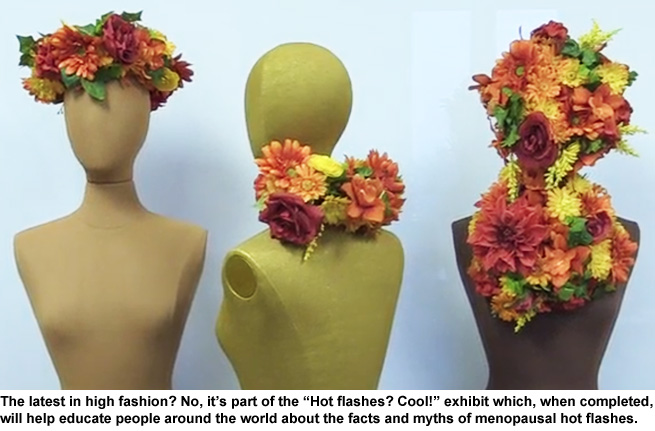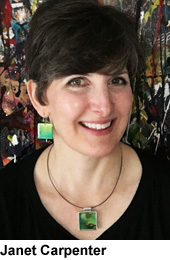My journey from bedside nurse to artist-scientist.

Who knew that women in Bangladesh and Mexico feel hot flashes differently than women in the United States and Europe? The author uses art to share this and other little-known facts.
Imagine living in a world where every woman on the planet goes through a health transition around age 50. For three out of four, it brings odd and uncontrollable sensations that happen at random times—day and night. Suddenly, you feel too hot, then too cold—blowtorch, freezer, blowtorch, freezer! Making matters worse, these odd phenomena are surrounded by myths, negativity, and confusing information.
 What I have just described is not imaginary; it’s reality. The transition is menopause and the sensations are hot flashes, also known as hot flushes and night sweats. Hot flashes are the cardinal symptom of menopause. A global phenomenon, they are marked by sudden rushes of heat and sweating, which are often followed by chills. Menopause has several stages, and hot flashes generally present when a woman’s periods become irregular in perimenopause, which begins several years before menopause, and stop altogether in postmenopause, when she has not had a menstrual period for at least 12 months.
What I have just described is not imaginary; it’s reality. The transition is menopause and the sensations are hot flashes, also known as hot flushes and night sweats. Hot flashes are the cardinal symptom of menopause. A global phenomenon, they are marked by sudden rushes of heat and sweating, which are often followed by chills. Menopause has several stages, and hot flashes generally present when a woman’s periods become irregular in perimenopause, which begins several years before menopause, and stop altogether in postmenopause, when she has not had a menstrual period for at least 12 months.
I wanted to know more
I first encountered hot flashes—observationally—while conducting dissertation research on coping among breast cancer survivors. Despite having been an oncology nurse for seven years, I was completely unprepared to see my research participants suddenly turn red in the face, sweat, fan themselves, and impulsively remove their clothing. Nearly all of them seemed to have hot flashes.
While doing postdoctoral work, I learned more about hot flashes and decided I should give this fascinating symptom my scientific attention. For the past 20 years, I have looked at ways to measure hot flashes, investigated their causes, and tested effects of various treatments ranging from prescription medications to slow and deep breathing. Insights from interdisciplinary collaborators, women taking part in my research studies, and my own early-menopause experience continue to inform my work.
I wanted others to know more
A turning point occurred in 2015 when I realized I needed to share my knowledge with the public. The North American Menopause Society had invited me to chair a panel of experts in writing a position statement on nonhormonal treatment options for hot flashes. The statement clearly outlined, based on available evidence, what our experts recommended and did not recommend as treatments for menopausal hot flashes. I thought it was a terrific resource for clinicians. But, I knew the information would not be readily accessible to the public and wondered how I could make it available to those who needed it. I applied for sabbatical leave to give me time to find a way to creatively disseminate this scientific information.
In 2016, my desire to get the word out was strengthened further when I observed myths, misinformation, and negative imagery about menopausal hot flashes that seemed to be everywhere—from product advertisements to websites, books, magazines, and other media. I was shocked to see similar imagery and myths propagated at an international conference. Slide and poster presentations by professionals—my colleagues—included significant inaccuracies about aging and distorted depictions of how women react to hot flashes. Even though the hot flashes I had experienced were severe, I could relate neither to the photos nor the women shown in them.
Using the creative arts to educate the public
I resolved to create a more balanced and scientifically based portrayal of hot flashes. During my 2017 sabbatical, I sketched out some of my ideas. As a visual person, I create pictures in my mind to understand verbal dialogue and written information, so sketches were a natural way for me to gather my thoughts. They revealed how I thought about menopausal hot flashes—both the facts and the myths.
It is not true, for example, that women always feel hot flashes on the chest or face. While that is typically true for women living in the United States and Europe, where women feel hot flashes varies somewhat by culture. Lynnette Leidy Sievert, PhD, has shown that women in Bangladesh feel hot flashes on the top of their head, and women in Mexico experience them on the back of their neck. Accordingly, I sketched three women, using red to show where they sensed hot flashes. Friends and colleagues with whom I shared these and other sketches encouraged me to continue my work.
Eventually, my ideas coalesced into an exhibit designed to teach the public about menopausal hot flashes. Networking with friends, nursing colleagues, women’s health experts, museum curators, and artists helped the concept grow. A local partnership with The daVinci Pursuit, which connects art, science, and community, has been integral to bringing my ideas to fruition. For example, its staff members influenced my depiction of cultural variations in where women sense hot flashes. Instead of red paint, we now use warm-colored flowers, which evoke blooming, blossoming, and naturalness. This approach combats myths that medicalize and pathologize the natural process of menopause and the normal hot flashes that accompany it.
My sabbatical enabled me to connect my interests in art and science. My background includes training in music, dance, theatre, sewing, and mixed media. The time away from my usual routine provided the opportunity to learn about and connect with people who combine art and science in unique ways. A growing number use the creative arts to teach scientific facts. The arts appeal to a broad range of people, transcend language, and convey a lot of information very succinctly. By engaging multiple senses, art increases learning and can change attitudes, beliefs, and behaviors. Bottom line? Using art to teach people about science can be very effective.
Proactive and interactive
The “Hot flashes? Cool!” exhibit will be large enough to walk through. It will contain sculptures and other visual art, digital media, and audio components that educate the public about menopausal hot flashes. With funding from Pfizer Inc. and Indiana University, my team and I are presently studying public reaction to a prototype exhibit in the form of a foam board model with miniature sculptures, graphic illustrations by a professional artist (based on my sketches), and descriptions of each element. Some of the pieces are interactive, allowing viewers to share written words or drawings to convey their own experiences and reactions.
We are also gathering data on feedback from men and women, both younger and older. Thus far, reactions have been very positive, and only a few changes have been needed to improve communication. Our next step is to hold public viewing events during which we pre-test and post-test attendees to ascertain if the exhibit is having the desired effect of evoking changes in how they think and feel about hot flashes.
To ensure that the exhibit is culturally relevant globally, we also plan to conduct similar studies in other parts of the world. In the meantime, we continue to identify funding opportunities and partners willing to help build and show the exhibit, which will eventually be full-size, in various locations.
As I reflect on my career, I am amazed at how my role has shifted from bedside nurse to scientist to artist-scientist. Nursing has allowed me to explore, experiment, and touch people of diverse backgrounds. The profession continues to open up new possibilities for leading and being a champion for women’s health. I look forward to building and showing the exhibit around the world and eventually creating more exhibits that address important topics that relate to women’s health. RNL
Janet S. Carpenter, PhD, RN, FAAN, is associate dean for research and distinguished professor, Indiana University School of Nursing, Indianapolis, Indiana, USA.